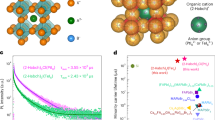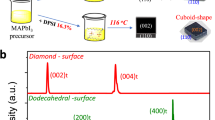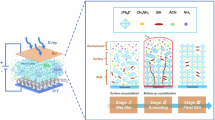Abstract
The instability of halide perovskites under working conditions or during complex postprocessing is challenging for practical applications. Here we developed a room-temperature, two-phase assembling strategy to synthesize single-unit-cell perovskite chains within single-walled carbon nanotubes (SWCNTs). This approach is efficient, scalable and tailorable, and can be used to assemble a range of single-chain perovskites. The single-unit-cell-chain perovskites show unconventional stoichiometries (such as [Cs4PbI5]+) due to dimensionality reduction and are balanced by negatively charged nanotubes. A direct X-ray detector constructed with high-entropy-Cs3MCl6@SWCNT exhibits outstanding performance, with a high sensitivity of \(1.22\times10^{4}\,\upmu{\mathrm{C}}\,{\mathrm{Gy}}_{\mathrm{air}}^{-1}\,{\mathrm{cm}}^{-2}\), a low dark current density of 0.2 nA cm−2, a negligible dark current drift of 8.5 × 10−7 nA cm−1 s−1 V−1 and a superior detection limit of 16.6 nGyair s−1. These surpass various common semiconductor and state-of-the-art perovskite detectors due to the ionic character of perovskite@SWCNT inducing a strong cation–π interaction, suppressing ion migration. The device is stable under harsh conditions, including continuous X-ray irradiation, high temperatures, exposure to ambient air for 91 days and immersion for 96 h in water. This low-cost synthetic methodology paves the way for the commercialization of potential perovskite X-ray detectors for medical and industrial applications.

This is a preview of subscription content, access via your institution
Access options
Subscribe to this journal
Receive 12 digital issues and online access to articles
118,99 € per year
only 9,92 € per issue
Buy this article
- Purchase on SpringerLink
- Instant access to full article PDF
Prices may be subject to local taxes which are calculated during checkout






Similar content being viewed by others
Data availability
All data that support this work are available within the paper and its Supplementary Information. Source data are provided with this paper. Crystallographic information files have also been deposited in the Inorganic Crystal Structure Database under reference numbers ICSD 161481, 201285, 29067, 177350, 28082, 131089, 262924, 241488, 68819, 53835, and in Material Project under reference numbers mp-27336 and mp-1112341. These data can be obtained free of charge via https://www.ccdc.cam.ac.uk/structures/ or https://next-gen.materialsproject.org/materials.
References
Wang, Y. et al. Thermodynamically stabilized β-CsPbI-based perovskite solar cells with efficiencies >18%. Science 365, 591–595 (2019).
Kim, Y. C. et al. Printable organometallic perovskite enables large-area, low-dose X-ray imaging. Nature 550, 87–91 (2017).
Wei, W. et al. Monolithic integration of hybrid perovskite single crystals with heterogenous substrate for highly sensitive X-ray imaging. Nat. Photon. 11, 315–321 (2017).
Shrestha, S. et al. High-performance direct conversion X-ray detectors based on sintered hybrid lead triiodide perovskite wafers. Nat. Photon. 11, 436–440 (2017).
Li, L. Q. et al. Monolithic integration of perovskite heterojunction on TFT backplanes through vapor deposition for sensitive and stable X-ray imaging. Sci. Adv. 10, eadj8659 (2024).
Nozik, A. J. et al. Semiconductor quantum dots and quantum dot arrays and applications of multiple exciton generation to third-generation photovoltaic solar cells. Chem. Rev. 110, 6873–6890 (2010).
Ahmed, G. H., Yin, J., Bakr, O. M. & Mohammed, O. F. Successes and challenges of core/shell lead halide perovskite nanocrystals. ACS Energy Lett. 6, 1340–1357 (2021).
Tian, J. et al. Inorganic halide perovskite solar cells: progress and challenges. Adv. Energy. Mater. 10, 2000183 (2020).
Protesescu, L. et al. Nanocrystals of cesium lead halide perovskites (CsPbX3, X = Cl, Br, and I): novel optoelectronic materials showing bright emission with wide color gamut. Nano Lett. 15, 3692–3696 (2015).
Rainò, G. et al. Ultra-narrow room-temperature emission from single CsPbBr3 perovskite quantum dots. Nat. Commun. 13, 2587 (2022).
Swarnkar, A. et al. Quantum dot–induced phase stabilization of α-CsPbI3 perovskite for high-efficiency photovoltaics. Science 354, 92–95 (2016).
Malgras, V. et al. Observation of quantum confinement in monodisperse methylammonium lead halide perovskite nanocrystals embedded in mesoporous silica. J. Am. Chem. Soc. 138, 13874–13881 (2016).
Dirin, D. N. et al. Harnessing defect-tolerance at the nanoscale: highly luminescent lead halide perovskite nanocrystals in mesoporous silica matrixes. Nano Lett. 16, 5866–5874 (2016).
Iijima, S. & Ichihashi, T. Single-shell carbon nanotubes of 1-nm diameter. Nature 363, 603–605 (1993).
Yang, F. et al. Chirality pure carbon nanotubes: growth, sorting, and characterization. Chem. Rev. 120, 2693–2758 (2020).
Allard, C. et al. Advanced 1D heterostructures based on nanotube templates and molecules. Chem. Soc. Rev. 53, 8457–8512 (2024).
Cao, K. et al. Atomic mechanism of metal crystal nucleus formation in a single-walled carbon nanotube. Nat. Chem. 12, 921–928 (2020).
Senga, R. et al. Atomic structure and dynamic behaviour of truly one-dimensional ionic chains inside carbon nanotubes. Nat. Mater. 13, 1050–1054 (2014).
Nakanishi, Y. et al. Template synthesis of linear-chain nanodiamonds inside carbon nanotubes from bridgehead-halogenated diamantane precursors. Angew. Chem. Int. Ed. 54, 10802–10806 (2015).
Shi, L. et al. Confined linear carbon chains as a route to bulk carbyne. Nat. Mater. 15, 634–639 (2016).
Pham, T. et al. Torsional instability in the single-chain limit of a transition metal trichalcogenide. Science 361, 263–266 (2018).
Gao, M. et al. Direct observation of transient structural dynamics of atomically thin halide perovskite nanowires. J. Am. Chem. Soc. 145, 4800–4807 (2023).
Kashtiban, R. J., Patrick, C. E., Ramasse, Q., Walton, R. I. & Sloan, J. Picoperovskites: the smallest conceivable isolated halide perovskite structures formed within carbon nanotubes. Adv. Mater. 35, e2208575 (2023).
Zhu, M. et al. Inner doping of carbon nanotubes with perovskites for ultralow power transistors. Adv. Mater. 36, 2403743 (2024).
Teng, Y. et al. Interfacial electron transfer in PbI2@single-walled carbon nanotube van der Waals heterostructures for high-stability self-powered photodetectors. J. Am. Chem. Soc. 146, 6231–6239 (2024).
Jiang, Y. et al. Ultrasmall single-layered NbSe2 nanotubes flattened within a chemical-driven self-pressurized carbon nanotube. Nat. Commun. 15, 475 (2024).
Villalva, J. et al. Spin-state-dependent electrical conductivity in single-walled carbon nanotubes encapsulating spin-crossover molecules. Nat. Commun. 12, 1578 (2021).
Folgueras, M. C., Jiang, Y., Jin, J. & Yang, P. High-entropy halide perovskite single crystals stabilized by mild chemistry. Nature 621, 282–288 (2023).
Song, Y. et al. High-entropy design for 2D halide perovskite. J. Am. Chem. Soc. 146, 19748–19755 (2024).
Wang, X. et al. Unexpectedly high salt accumulation inside carbon nanotubes soaked in dilute salt solutions. Phys. Rev. Lett. 121, 226102 (2018).
Tunuguntla, R. H., Allen, F. I., Kim, K., Belliveau, A. & Noy, A. Ultrafast proton transport in sub-1-nm diameter carbon nanotube porins. Nat. Nanotechnol. 11, 639–644 (2016).
Tunuguntla, R. H. et al. Enhanced water permeability and tunable ion selectivity in subnanometer carbon nanotube porins. Science 357, 792–796 (2017).
Cambre, S. et al. Asymmetric dyes align inside carbon nanotubes to yield a large nonlinear optical response. Nat. Nanotechnol. 10, 248–252 (2015).
Wen, L., Zhang, X., Tian, Y. & Jiang, L. Quantum-confined superfluid: from nature to artificial. Sci. China Mater. 61, 1027–1032 (2018).
Xue, Y. H. et al. Atomic-scale ion transistor with ultrahigh diffusivity. Science 372, 501–503 (2021).
Shi, G. et al. Two-dimensional Na–Cl crystals of unconventional stoichiometries on graphene surface from dilute solution at ambient conditions. Nat. Chem. 10, 776–779 (2018).
Jordan, J. W. et al. Host–guest hybrid redox materials self-assembled from polyoxometalates and single-walled carbon nanotubes. Adv. Mater. 31, 1904182 (2019).
Yang, X. et al. Host–guest molecular interaction enabled separation of large-diameter semiconducting single-walled carbon nanotubes. J. Am. Chem. Soc. 143, 10120–10130 (2021).
Zhao, X. et al. Sorting of cluster confined metallic single-walled carbon nanotubes for fabricating atomically vacant uranium oxide. J. Am. Chem. Soc. 145, 25242–25251 (2023).
Wang, K. et al. Advances in liquid-phase assembly of cluster into single-walled carbon nanotubes. ACS Appl. Mater. Interfaces 16, 51826–51836 (2024).
Zhao, J., Han, J. & Lu, J. P. Work functions of pristine and alkali-metal intercalated carbon nanotubes and bundles. Phys. Rev. B 65, 193401 (2002).
Rao, A. M., Eklund, P. C., Bandow, S., Thess, A. & Smalley, R. E. Evidence for charge transfer in doped carbon nanotube bundles from Raman scattering. Nature 388, 257–259 (1997).
Seo, D. et al. One-dimensional gold nanostructures through directed anisotropic overgrowth from gold decahedrons. J. Phys. Chem. C 113, 3449–3454 (2009).
Straus, D. B., Guo, S. & Cava, R. J. Kinetically stable single crystals of perovskite-phase CsPbI3. J. Am. Chem. Soc. 141, 11435–11439 (2019).
Lin, H. et al. Epitaxial growth of lead-free double perovskite shell for CsPbX3/Cs2SnX6 (X = Cl, Br, and I) core/shell perovskite nanocrystals with enhanced photoelectric properties and stability. Adv. Funct. Mater. 34, 2309480 (2023).
Zhan, C. et al. Subnanometer high-entropy alloy nanowires enable remarkable hydrogen oxidation catalysis. Nat. Commun. 12, 6261 (2021).
Yang, S. et al. Highly circularly polarized light-sensitive chiral one-dimensional perovskites enabled by antisolvent engineering. Adv. Funct. Mater. 34, 2310917 (2024).
Xu, Y. et al. Tailoring multi-phenyl ring cation for stable scalable hybrid bismuth iodide amorphous film: enabling record sensitivity and high-performance X-ray array imaging. Adv. Mater. 36, 2406128 (2024).
Clairand, I. et al. Use of active personal dosemeters in interventional radiology and cardiology: tests in laboratory conditions and recommendations—ORAMED project. Radiat. Meas. 46, 1252–1257 (2011).
Otsuka, K., Inoue, T., Chiashi, S. & Maruyama, S. Selective removal of metallic single-walled carbon nanotubes in full length by organic film-assisted electrical breakdown. Nanoscale 6, 8831–8835 (2014).
Zhan, P. et al. Research progress of one-dimensional van der Waals atomic chain materials. Sci. China Mater. 68, 364–386 (2025).
Hunter, D. M., Belev, G., Kasap, S. & Yaffe, M. J. Measured and calculated K-fluorescence effects on the MTF of an amorphous-selenium based CCD X-ray detector. Med. Phys. 39, 608–622 (2012).
Thirimanne, H. M. et al. Hybrid multipixel array X-ray detectors for real-time direct detection of hard X-rays. IEEE Trans. Nucl. Sci. 67, 2238–2245 (2020).
Schieber, M., Zuck, A., Gilboa, H. & Zentai, G. Reviewing polycrystalline mercuric iodide X-ray detectors. IEEE Trans. Nucl. Sci. 53, 2385–2391 (2006).
Achmadullin, R. A. et al. Photovoltaic X-ray detectors based on epitaxial GaAs structures. Nucl. Instrum. Methods Phys. Res. A 554, 314–319 (2005).
Tokuda, S., Kishihara, H., Adachi, S. & Sato, T. Preparation and characterization of polycrystalline CdZnTe films for large-area, high-sensitivity X-ray detectors. J. Mater. Sci. Mater. Electron. 15, 1–8 (2004).
Huang, W. C., Tseng, Z. C., Hsueh, W. J., Liao, S. Y. & Huang, C. Y. X-ray detectors based on amorphous InGaZnO thin films. IEEE Trans. Electron Dev. 70, 3690–3694 (2023).
Liang, H. L. et al. Flexible X-ray detectors based on amorphous Ga2O3 thin films. ACS Photonics 6, 351–359 (2019).
Hua, Y. et al. Suppressed ion migration for high-performance X-ray detectors based on atmosphere-controlled EFG-grown perovskite CsPbBr3 single crystals. Nat. Photon. 18, 870–877 (2024).
Du, X. et al. Chemical potential diagram guided rational tuning of electrical properties: a case study of CsPbBr3 for X-ray detection. Adv. Mater. 34, 2110252 (2022).
Li, W. et al. Evaporated perovskite thick junctions for X-ray detection. ACS Appl. Mater. Interfaces 13, 2971–2978 (2021).
Zhao, J. J. et al. Perovskite-filled membranes for flexible and large-area direct-conversion X-ray detector arrays. Nat. Photon. 14, 612–617 (2020).
Liu, L. et al. Anti-perovskites with long carrier lifetime for ultralow dose and stable X-ray detection. Nat. Photon. 18, 990–997 (2024).
Acknowledgements
We gratefully acknowledge Z. W. Quan and Y. Wei for valuable discussions and the Core Research Facilities of SUSTech for characterization. F.Y. acknowledges support from the National Natural Science Foundation of China (NSFC) (22222504, 22475093, 92161124, 92461307), the National Key Research and Development Program of China (2021YFA0717400), the Shenzhen Basic Research Project (JCYJ20210324104808022), the State Key Laboratory of Advanced Fiber Materials (Donghua University) (KF2504) and the Guangdong Pearl River Talent Plan (2021QN02C104). Y.L. acknowledges support from the NSFC (52203342, 62304236), the National Key Research and Development Program of China (2024YFF0507802), the Shenzhen Basic Research Project (JCYJ20240813155804007), the Young Elite Scientist Sponsorship Program by Cast of China Association for Science and Technology (YESS20210285) and the Guangdong Pearl River Talent Plan (2021QN02Y300). DFT calculations were performed with the CHEM high-performance supercomputer cluster (CHEM-HPC) located at Department of Chemistry, SUSTech.
Author information
Authors and Affiliations
Contributions
F.Y. conceived the project. F.Y. and Y.L. co-supervised the project and led the collaboration efforts. M.S. performed material synthesis. M.S., K.W., Y.J., G.J., X.Z. and B.Y. performed the characterizations. B.L. performed theoretical calculations. B.Z. and Y.L. contributed to the devices. F.Y., M.S., Y.L. and B.Z. wrote and revised the manuscript. All authors analysed the data, discussed the results and approved the manuscript.
Corresponding authors
Ethics declarations
Competing interests
F.Y. and M.S. declare a financial interest: a patent related to this research has been submitted. The remaining authors declare no competing financial interests.
Peer review
Peer review information
Nature Synthesis thanks Paul Sellin and Jeremy Sloan for their contribution to the peer review of this work. Primary Handling Editor: Alexandra Groves, in collaboration with the Nature Synthesis team.
Additional information
Publisher’s note Springer Nature remains neutral with regard to jurisdictional claims in published maps and institutional affiliations.
Extended data
Extended Data Fig. 1 Evidence of negatively charged SWCNT after filling perovskite.
a, Density of states of CsPbI3@(20,0)-SWCNT and projected density of states of (20,0)-SWCNT and [Cs4PbI5]. Fermi levels of CsPbI3@(20,0)-SWCNT and empty (20,0)-SWCNT are labelled, which is calculated by HSE06 functional. b, Raman spectra showing G band of CsPbI3@SWCNT and empty-SWCNT. Excitation wavelength: 532 nm.
Extended Data Fig. 2 Resistance of devices measured in the dark condition.
a, Senary Cs3MCl6@SWCNT. b, CsPbBr3@SWCNT. c, CsPbI3@SWCNT.
Extended Data Fig. 3 Bias-dependent photocurrent of senary Cs3MCl6@SWCNT device.
A modified Hecht equation is used to fit the obtained photoconductivity curve by the equation: \(I=\frac{{I}_{0}\mu \tau V}{{L}^{2}}[1-\exp (-\frac{{L}^{2}}{\mu \tau V})]\) where I0 is the saturated photoinduced signal current, V is the applied bias, and L is the thickness of the sample.
Extended Data Fig. 4 Photocurrent and dark current drift.
I-t curves of senary Cs3MCl6@SWCNT device in the dark and irradiation conditions with a bias of 200 V.
Extended Data Fig. 5 Ion-migration activation energy.
a, Senary Cs3MCl6@SWCNT. b, CsPbBr3@SWCNT. c, CsPbI3@SWCNT.
Extended Data Fig. 6 LoD evaluation.
a, I-t curves of senary Cs3MCl6@SWCNT device under a pulsing X-ray irradiation with different dose rates. b, X-ray dose rate dependent signal-to-noise ratio for LoD evaluation.
Extended Data Fig. 7 Statistic box showing the reproducibility of senary Cs3MCl6@SWCNT devices.
a, Sensitivities obtained at 50–200 V biases. b, LoD obtained at 200 V bias. c, Dark current drift obtained at 200 V bias. d, Dark current obtained at the 200 V bias. The data in (a–d) are collected from 6 different devices (n = 6) fabricated by the same materials and procedures. The upper line of the whisker represents the maximum value of the group of data, the lower line of the whisker represents the minimum value of the group of data, the upper edge of the box is the 75% quantile of the group of data, the lower edge of the box is the 25% quantile of the group of data, the middle line of the box is the median of the group of data, the curve is the average normal distribution of the group of data, and the white square in the centre of the box represents the mean of the group of the data.
Extended Data Fig. 8 Long-term storage stability of the senary Cs3MCl6@SWCNT device.
Normalized current-time curves when exposing the device to ambient air for 91 days.
Supplementary information
Supplementary Information
Supplementary Methods, Figs. 1–26, Tables 1–10, References 1–17 and caption for Supplementary Video 1.
Supplementary Video 1
A real-time movie of molecular dynamic simulations showing the diffusion behaviours of DMSO and cyclohexane molecules inside a (18,0) SWCNT with a diameter of 14.2 Å in 100 ns. Frame rate of video: 30 frame·s–1.
Source data
Source Data Fig. 1
Statistical Source Data.
Source Data Fig. 3
Statistical Source Data.
Source Data Fig. 4
MD Simulation Source Data.
Source Data Fig. 5
XPS Source Data.
Source Data Fig. 6
Statistical Source Data.
Source Data Extended Data Fig. 1
Raman Source Data.
Source Data Extended Data Fig. 2
Device Source Data.
Source Data Extended Data Fig. 3
Device Source Data.
Source Data Extended Data Fig. 4
Device Source Data.
Source Data Extended Data Fig. 5
Device Source Data.
Source Data Extended Data Fig. 6
Device Source Data.
Source Data Extended Data Fig. 7
Device Source Data.
Source Data Extended Data Fig. 8
Device Source Data.
Rights and permissions
Springer Nature or its licensor (e.g. a society or other partner) holds exclusive rights to this article under a publishing agreement with the author(s) or other rightsholder(s); author self-archiving of the accepted manuscript version of this article is solely governed by the terms of such publishing agreement and applicable law.
About this article
Cite this article
Song, M., Zhao, B., Li, B. et al. Synthesis of single-unit-cell-thick perovskites by liquid-phase confined assembly for high-performance ultrastable X-ray detectors. Nat. Synth (2025). https://doi.org/10.1038/s44160-025-00785-9
Received:
Accepted:
Published:
DOI: https://doi.org/10.1038/s44160-025-00785-9
This article is cited by
-
Encapsulated halide perovskites
Nature Synthesis (2025)



